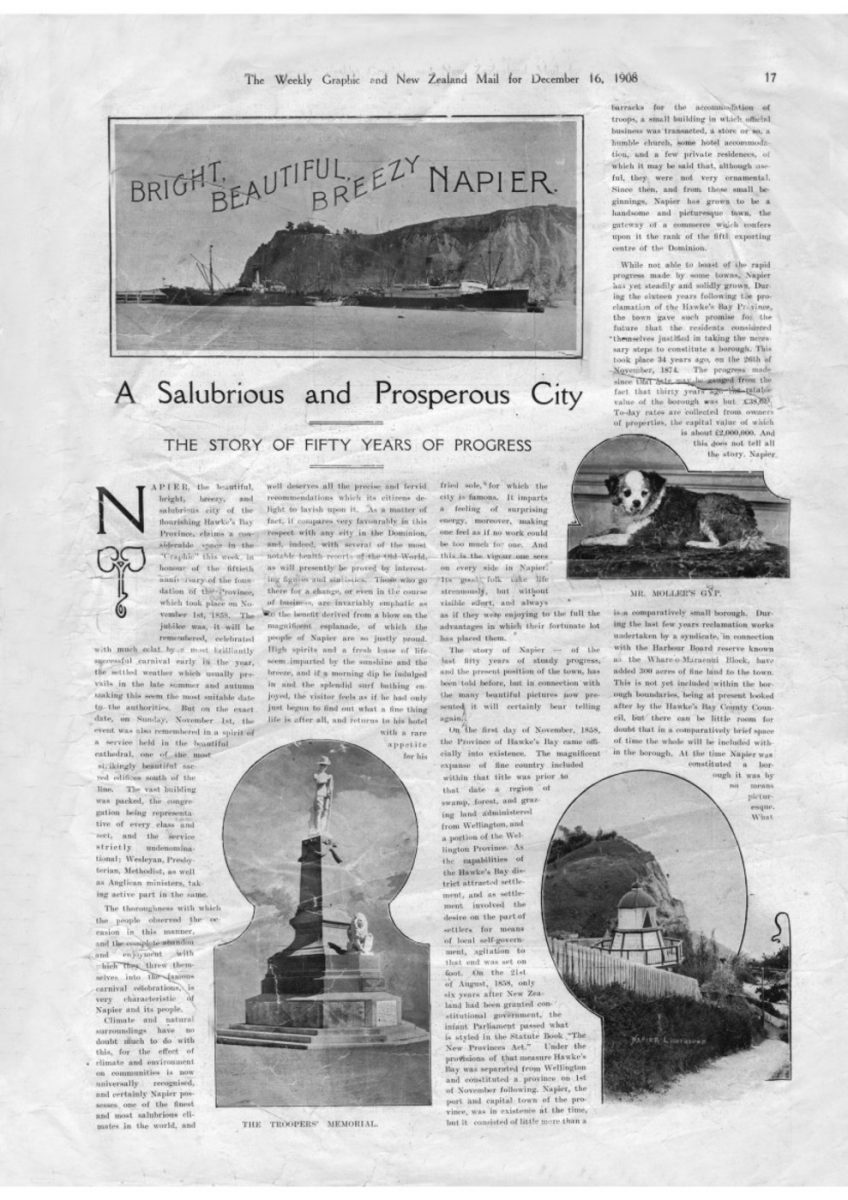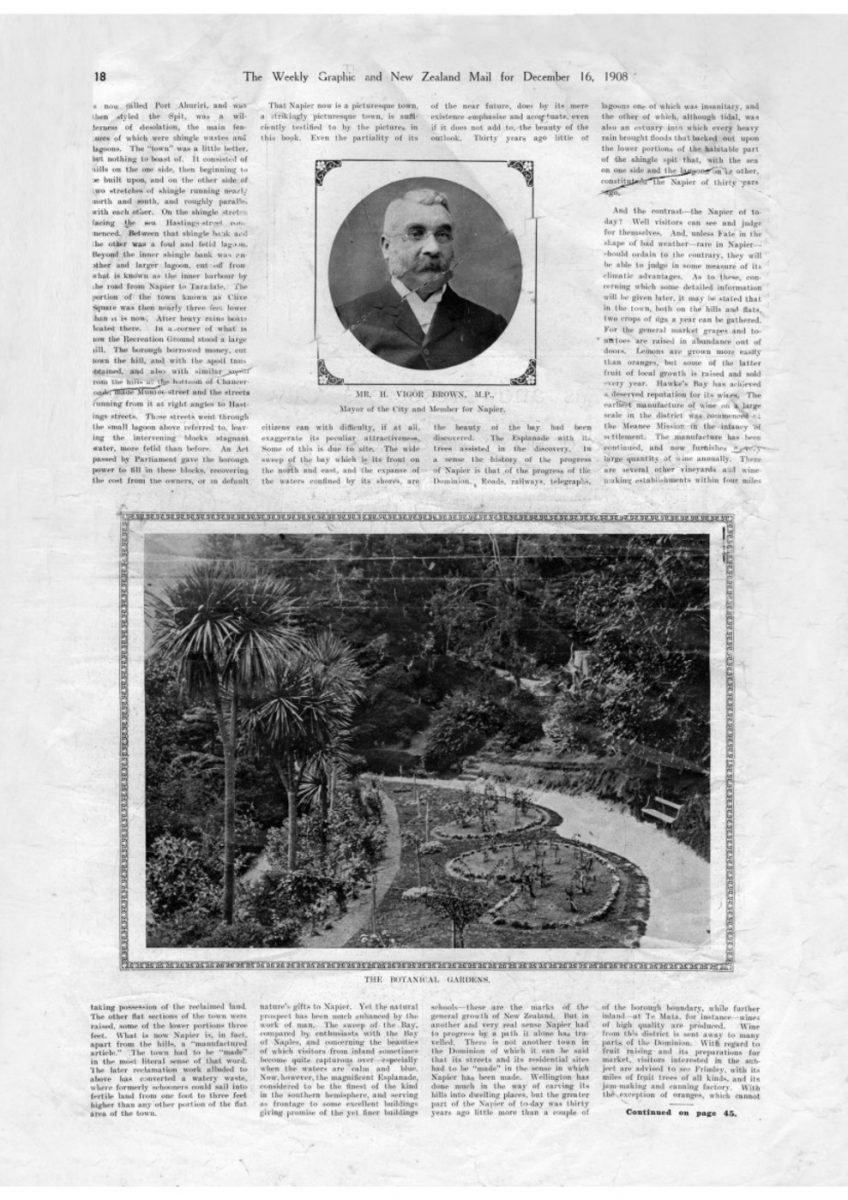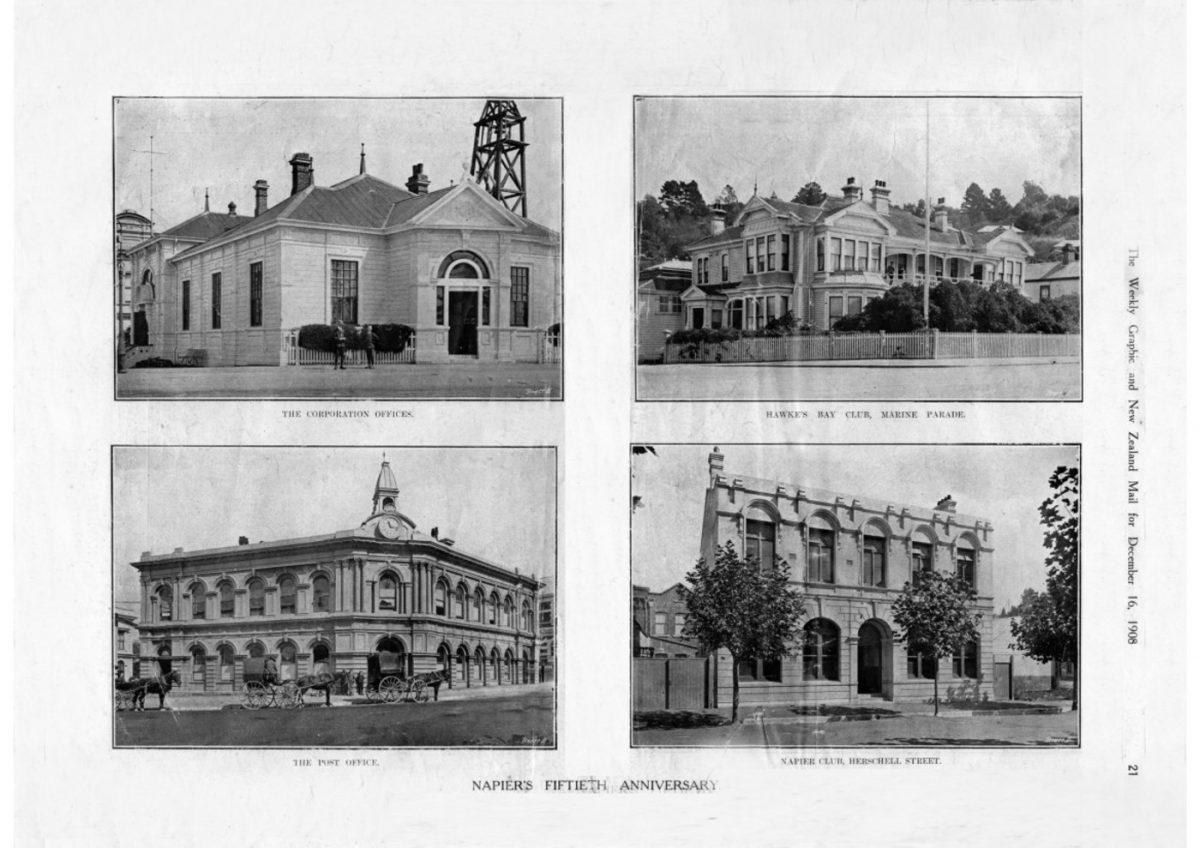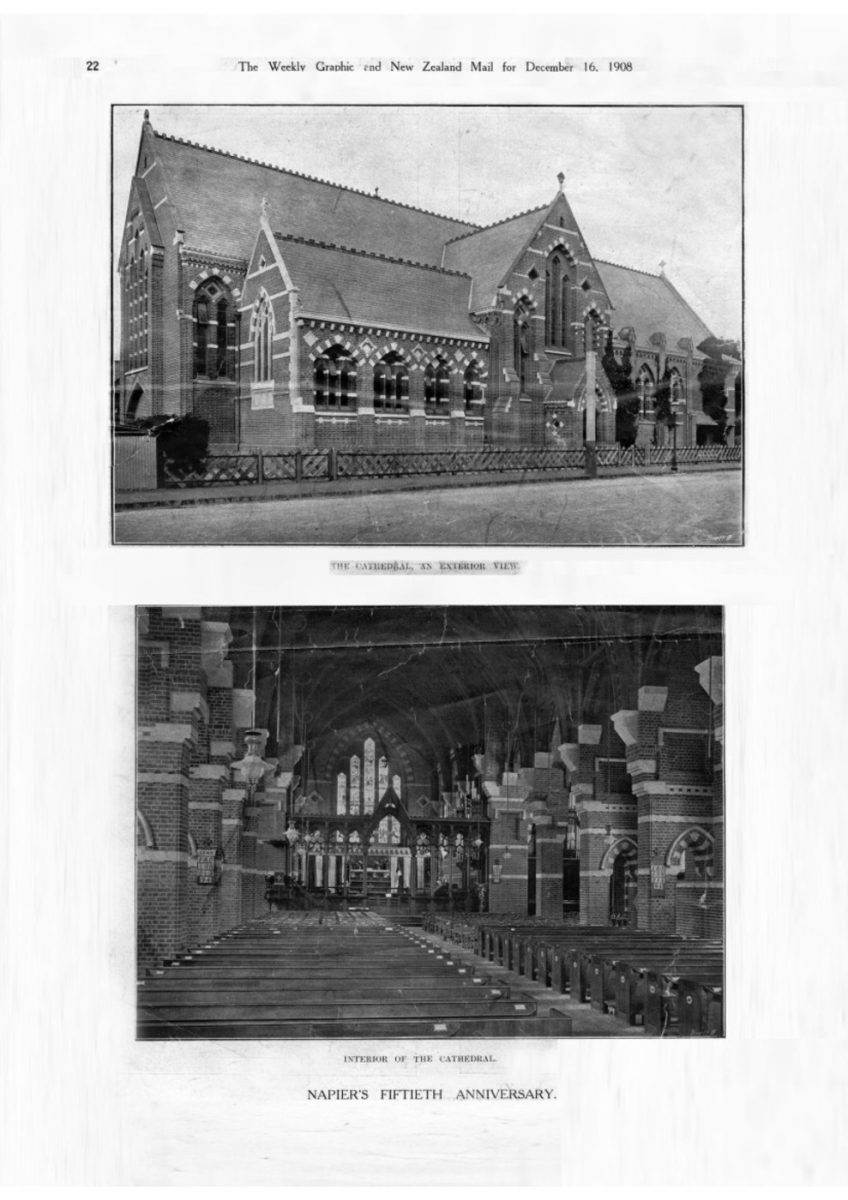- Home
- Collections
- DURNEY T
- Weekly Graphic and New Zealand Mail, The, 16 December 1908
Weekly Graphic and New Zealand Mail, The, 16 December 1908
The Weekly Graphic and New Zealand Mail for December 16, 1908 17
BRIGHT, BEAUTIFUL, BREEZY NAPIER.
A Salubrious and Prosperous City
THE STORY OF FIFTY YEARS OF PROGRESS
NAPIER, the beautiful, bright, breezy and salubrious city of the flourishing Hawke’s Bay Province, claims a considerable space in the “Graphic” this week, in honour of the fiftieth anniversary of the foundation of the Province, which took place on November 1st, 1858. The jubilee was, it will be remembered, celebrated with much éclat by a most brilliantly successful carnival early in the year, the settled weather which usually prevails in the late summer and autumn making this seem the most suitable date to the authorities. But on the exact date, on Sunday, November 1st, the event was also remembered in a spirit of a service held in the beautiful cathedral, one of the most strikingly beautiful sacred edifices south of the line. The vast building was packed, the congregation being representative of every class and sect, and the service strictly undenominational; Wesleyan, Presbyterian, Methodist, as well as Anglican ministers, taking active part in the same.
The thoroughness with which the people observed the occasion in this manner, and the complete abandon and enjoyment with which they threw themselves into the famous carnival celebrations, is very characteristic of Napier and its people.
Climate and natural surroundings have no doubt much to do with this, for the effect of climate and environment on communities is now universally recognised, and certainly Napier possesses one of the finest and most salubrious climates in the world, and well deserves all the precise and fervid recommendations which its citizens delight to lavish upon it. As a matter of fact, it compares very favourably in this respect with any city in the Dominion, and, indeed, with several of the most notable health resorts of the Old World, as will presently be proved by interesting figures and statistics. Those who go there for a change, or even in the course of business, are invariably emphatic as to the benefit derived from a blow on the magnificent esplanade, of which the people are so justly proud. High spirits and a fresh lease of life seem imparted by the sunshine and the breeze, and if a morning dip be indulged in and the splendid surf bathing enjoyed, the visitor feels as if he had only just begun to find out what a fine thing life is after all, and returns to his hotel with a rare appetite for his fried sole, for which the city is famous. It imparts a feeling of surprising energy, moreover, making one feel as if no work could be too much for one. And this is the vigour one sees on every side in Napier. Its good folk take life strenuously, but without visible effort, and always as if they were enjoying to the full the advantages in which their fortunate lot has placed them.
The story of Napier – of the last fifty years of steady progress, and the present position of the town, has been told before, but in connection with the many beautiful pictures now presented it will certainly bear telling again.
On the first day of November, 1858, the Province of Hawke’s Bay came officially into existence. The magnificent expanse of fine country included within that title was prior to that date a region of swamp, forest, and grazing land administered from Wellington, and a portion of the Wellington Province. As the capabilities of the Hawke’s Bay district attracted settlement, and as settlement involved the desire on the part of settlers for means of local self-government, agitation to that end was set on foot. On the 21st of August, 1858, only six years after New Zealand had been granted constitutional government, the infant Parliament passed what is styled in the Statute Book “The New Provinces Act.” Under the provisions of that measure Hawke’s Bay was separated from Wellington and constituted a province on 1st of November following. Napier, the port and capital town of the province, was in existence at the time, but it consisted of little more than a barracks for the accommodation of troops, a small building in which official business was transacted, a store or so, a humble church, some hotel accommodation, and a few private residences, of which it may be said that, although useful, they were not very ornamental. Since then, and from those small beginnings, Napier has grown to be a handsome and picturesque town, the gateway of a commerce which confers upon it the rank of the fifth exporting centre of the Dominion.
While not able to boast of the rapid progress made by some towns, Napier has yet steadily and solidly grown. During the sixteen years following the proclamation of the Hawke’s Bay Province, the town gave such promise for the future that the residents considered themselves justified in taking the necessary steps to constitute a borough. This took place 34 years ago, on the 26th of November, 1874. The progress made since that date may be gauged from the fact that thirty years ago the ratable [rateable] value of the borough was but £38.000. To-day rates are collected from owners of properties, the capital value of which is about £2,000,000. And this does not tell all the story. Napier is a comparatively small borough. During the last few years reclamation works undertaken by a syndicate, in connection with the Harbour Board reserve known as the Whare-o-Maraenui Block, have added 300 acres of fine land to the town. This is not yet included within the borough boundaries, being at present looked after by the Hawke’s Bay County Council, but there can be little room for doubt that in a comparatively brief space of time the whole will be included within the borough. At the time Napier was constituted a borough it was by no means picturesque. What
Photo captions –
THE TROOPERS’ MEMORIAL..
MR. MOLLER’S GYP.
NAPIER LIGHTHOUSE

Page 02
18 The Weekly Graphic and New Zealand Mail for December 16, 1908
is now called Port Ahuriri, and was then styled the Spit, was a wilderness of desolation, the main features of which were shingle wastes and lagoons. The “town” was a little better, but nothing to boast of. It consisted of hills on the one side, then beginning to be built upon, and on the other side of two stretches of shingle running nearly north and south, and roughly parallel with each other. On the shingle stretch facing the sea Hastings-street commenced. Between that shingle bank and the other was a foul and fetid lagoon. Beyond the inner shingle bank was another larger lagoon, cut off from what is known as the inner harbour by the road from Napier to Taradale. The portion of the town known as Clive Square was then nearly three feet lower than it is now. After heavy rains boats floated there. In a corner of what is now the Recreation Ground stood a large hill. The borough borrowed money, cut down the hill, and with the spoil thus obtained, and also with similar spoil from the hill at the bottom of Chaucer-road, made Munroe-street and the streets running from it at right angles to Hastings-streets. These streets went through the small lagoon above referred to, leaving the intervening blocks stagnant water, more fetid than before. An Act passed by Parliament gave the borough power to fill in these blocks, recovering the cost from the owners, or in default taking possession of the reclaimed land. The other flat sections of the land were raised, some of the lower portions three feet. What is now Napier is, in fact, apart from the hills, a “manufactured article.” The town had to be “made” in the most literal sense of the word. The later reclamation work alluded to above has converted a watery waste, where formerly schooners could sail into fertile land from one foot to three feet higher than any other portion of the flat area of the town.
That Napier is now a picturesque town, a strikingly picturesque town, is sufficiently testified to by the pictures in this book. Even the partiality of its citizens can with difficulty, if at all, exaggerate its peculiar attractiveness. Some of this is due to site. The wide sweep of the bay which is its front on the north and east, and the expanse of waters confined by its shores, are nature’s gifts to Napier. Yet the natural prospect has been enhanced by the work of man. The sweep of the Bay, compared by enthusiasts with the Bay of Naples, and concerning the beauties of which visitors from inland sometimes become quite rapturous over – especially when the waters are calm and blue. Now, however, the magnificent Esplanade, considered to be the finest in the southern hemisphere, and serving as frontage to some excellent buildings giving promise of the yet finer buildings of the near future, does by its mere existence emphasise and accentuate, even if it does not add to, the beauty of the outlook. Thirty years ago little of the beauty had been discovered. The Esplanade with its trees assisted in the discovery. In a sense the history of the progress of Napier is that of the progress of the Dominion. Roads, railways, telegraphs, schools – these are the marks of the general growth of New Zealand. But in another and very real sense Napier had to progress by a path it alone has travelled. There is not another town in the Dominion of which it can be said that its streets and its residential site had to be “made” in the sense in which Napier has been made. Wellington has done much in the way of carving its hills into dwelling places, but the greater part of the Napier of to-day was thirty years ago little more than a couple of lagoons one of which was insanitary, and the other of which, although tidal, was also an estuary into which every heavy rain brought floods that backed out upon the lower portions of the habitable part of the shingle spit that, with the sea on one side and the lagoon on the other, constituted the Napier of thirty years ago.
And the contrast – the Napier of to-day? Well visitors can see and judge for themselves. And, unless Fate in the shape of bad weather – rare in Napier – should ordain to the contrary, they will be able to judge in some measure of its climatic advantages. As to these, concerning which some detailed information will be given later, it may be stated that in the town, both on the hills and flats, two crops of figs a year can be gathered. For the general market grapes and tomatoes are raised in abundance out of doors. Lemons are grown more easily than oranges, but some of the latter fruit of local growth is raised and sold every year. Hawke’s Bay has achieved a deserved reputation for its wines. The earliest manufacture of wine on a large scale in the district was commenced at the Meanee [Meeanee] Mission in the infancy of the settlement. The manufacture has been continued, and now furnishes a very large quantity of wine annually. There are several other vineyards and wine-making establishments within four miles of the borough boundary, while further inland – at Te Mata, for instance – wines of high quality are produced. Wine from this district is sent away to many parts of the Dominion. With regard to fruit raising and its preparations for market, visitors interested in the subject are advised to see Frimley, with its miles of fruit trees of all kinds, and its jam-making and canning factory. With the exception of oranges, which cannot
[rest of article missing – HBKB]
Photo captions –
MR. H [J]. VIGOR BROWN, M.P.,
Mayor of the City and Member for Napier.
THE BOTANICAL GARDENS.

Non-commercial use

This work is licensed under a Attribution-NonCommercial 3.0 New Zealand (CC BY-NC 3.0 NZ).
Commercial Use
Please contact us for information about using this material commercially.Can you help?
The Hawke's Bay Knowledge Bank relies on donations to make this material available. Please consider making a donation towards preserving our local history.
Visit our donations page for more information.
Subjects
Tags
Format of the original
Newspaper articleDate published
16 December 1908Publisher
The Weekly Graphic and New Zealand MailPeople
- Mayor J Vigor Brown
- Mr Moller




















Do you know something about this record?
Please note we cannot verify the accuracy of any information posted by the community.